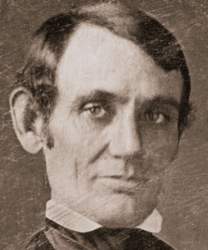Record Data
Source citation
Abraham Lincoln, Application for Patent on an Improved Method of Lifting Vessels over Shoals, 10 March 1849, in Roy P. Basler, ed., The Collected Works of Abraham Lincoln (8 vols., New Brunswick, NJ: Rutgers University Press, 1953), 2: 32-36, http://quod.lib.umich.edu/l/lincoln/.
Type
Miscellaneous
Date Certainty
Exact
Transcriber
Transcription adapted from The Collected Works of Abraham Lincoln (1953), edited by Roy P. Basler
Adapted by Matthew Pinsker, Dickinson College
Transcription date
Transcription
The following text is presented here in complete form, as it originally appeared in print. Spelling and typographical errors have been preserved as in the original.
March 10, 1849
…To all whom it may concern:
Be it known that I, Abraham Lincoln, of Springfield, in the county of Sangamon, in the state of Illinois, have invented a new and improved manner of combining adjustable buoyant air chambers with a steam boat or other vessel for the purpose of enabling their draught of water to be readily lessened to enable them to pass over bars, or through shallow water, without discharging their cargoes; and I do hereby declare the following to be a full, clear, and exact description thereof, reference being had to the accompanying drawings making a part of this specification. Similar letters indicate like parts in all the figures.
The buoyant chambers A. A. which I employ, are constructed in such a manner that they can be expanded so as to hold a large volume of air when required for use, and can be contracted, into a very small space and safely secured as soon as their services can be dispensed with…
…I wish it to be distinctly understood, that I do not intend to limit myself to any particular mechanical arrangement, in combining expansible buoyant chambers with a vessel, but shall vary the same as I may deem expedient, whilst I attain the same end by substantially the same means. What I claim as my invention and desire to secure by letters patent, is the combination of expansible buoyant chambers placed at the sides of a vessel, with the main shaft or shafts C, by means of the sliding spars, or shafts D, which pass down through the buoyant chambers and are made fast to their bottoms, and the series of ropes and pullies, or their equivalents, in such a manner that by turning the main shaft or shafts in one direction, the buoyant chambers will be forced downwards into the water and at the same time expanded and filled with air for buoying up the vessel by the displacement of water; and by turning the shaft in an opposite direction, the buoyant chambers will be contracted into a small space and secured against injury.
Witness
Z. C. ROBBINS
A. LINCOLN
H. H. SYLVESTER


